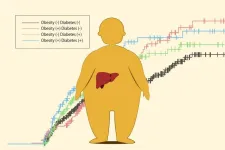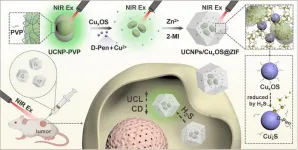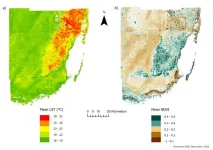(Press-News.org) Oysters once formed extensive reefs along much of Europe's coastline – but these complex ecosystems were destroyed over a century ago, new research shows.
Based on documents from the 18th and 19th Centuries, the study reveals that European flat oysters formed large reefs of both living and dead shells, providing a habitat supporting rich biodiversity.
Today these oysters are mostly found as scattered individuals – but the researchers found evidence of reefs almost everywhere, from Norway to the Mediterranean, covering at least 1.7 million hectares, an area larger than Northern Ireland.
The research was led by the University of Exeter and The University of Edinburgh.
Native oyster reefs created their own ecosystems, full of a diverse range of underwater life – supporting a greater number of species than surrounding areas.
In addition to creating homes for the almost 200 recorded fish and crustacean species, the oysters also played a vital role in stabilising shorelines, nutrient cycling and water filtration – with a single adult oyster filtering up to 200 litres of water a day.
Restoration projects are under way across Europe – and small-scale habitat restoration, such as The Wild Oyster Project, led by ZSL and partners, are key stepping stones to the return of these vital ecosystems on an international scale.
However, restoration efforts need to be scaled up with support from governments and other decision makers across the continent.
“Human activities have affected the ocean for centuries,” said Dr Ruth Thurstan, from the University of Exeter and part of the Convex Seascape Survey, an ambitious five-year project examining ocean carbon storage.
“This makes it difficult to discover what our marine ecosystems used to look like, which in turn hampers conservation and recovery.
“Few people in the UK today will have seen a flat oyster, which is our native species. Oysters still exist in these waters but they’re scattered, and the reefs they built are gone.
“We tend to think of our seafloor as a flat, muddy expanse, but in the past many locations were a three-dimensional landscape of complex living reefs – now completely lost from our collective memory.”
Due to their economic and cultural significance, oysters feature in historical records including newspapers, books, travel writing, landing records, nautical charts, early scientific investigations and interviews with fishermen.
“By combining descriptive accounts from a range of historical sources, we can build a picture of our past seas,” said Dr Thurstan, who is mapping past ocean changes as part of the Convex Seascape Survey.
“The greatest concentration of oyster reefs we found was in the North Sea.”
Records show extensive reefs existed along the coasts of modern France, Denmark, Germany, the Netherlands, the Republic of Ireland and the UK.
“Oyster reefs are slow to develop, with layers of new oysters building up on the dead shells of their predecessors, but their destruction through overfishing was relatively rapid,” said Dr Philine zu Ermgassen, honorary researcher at the University of Edinburgh.
“This has caused a fundamental restructuring and ‘flattening’ of our seafloors – removing thriving ecosystems and leaving an expanse of soft sediment behind.
“Thanks to this historical ecology research, we are now able to quantitatively describe what oyster reefs looked like before they were impacted, and the spatial extent of the ecosystems they formed.
“These were huge areas that were thickly crusted with oysters and crawling with other marine life.”
The research team was made up of more than 30 European researchers from the Native Oyster Restoration Alliance.
The study was partly funded by the European Research Council.
The paper, published in the journal Nature Sustainability, is entitled: “Records reveal the vast historical extent of European oyster reef ecosystems.”
END
Oyster reefs once thrived along Europe’s coasts – now they’re gone
2024-10-03
ELSE PRESS RELEASES FROM THIS DATE:
Decades-long research reveals new understanding of how climate change may impact caches of Arctic soil carbon
2024-10-03
Utilizing one of the longest-running ecosystem experiments in the Arctic, a Colorado State University-led team of researchers have developed a better understanding of the interplay among plants, microbes and soil nutrients — findings that offer new insight into how critical carbon deposits may be released from thawing Arctic permafrost.
Estimates suggest that Arctic soils contain nearly twice the amount of carbon that is currently in the atmosphere. As climate change has caused portions of Earth’s northernmost polar regions to thaw, scientists have long been concerned about significant amounts of carbon being released in the ...
How Soviet legacy has influenced foreign policy in Georgia and Ukraine
2024-10-03
The legacy of the Soviet Union’s collapse plays a greater role in the foreign policies of Georgia and Ukraine than previous studies have suggested. Conducting foreign policy in former Soviet countries can be a major challenge as the Russian state does not accept the new order. These are the findings outlined in the thesis of political scientist Per Ekman from Uppsala University.
“To understand Russia’s war in Ukraine, for example, it is important to see the war as part of a longer historical event. Since their first day of independence, Georgia and Ukraine have had to deal with Russian ambitions to control the region. For many in the West, it took a ...
Robin Dunbar: Pioneering evolutionary psychologist redefines human social networks
2024-10-03
Oxford, UK – Genomic Press has released a captivating interview with Professor Robin Dunbar, the eminent evolutionary psychologist and anthropologist whose work has fundamentally altered our understanding of human social networks. Published in the Innovators and Ideas section of Genomic Psychiatry, this in-depth conversation offers unique insights into Professor Dunbar's scientific journey and the far-reaching implications of his research.
Professor Dunbar, best known for conceptualizing "Dunbar's number" - the cognitive limit to the number of stable social relationships ...
Balancing health: diabetes and obesity increase risk of liver cancer relapse
2024-10-03
Hepatocellular carcinoma, a type of liver cancer associated with hepatitis infections, is known to have a high recurrence rate after cancer removal. Recent advances in antiviral therapy have reduced the number of patients affected, but obesity and diabetes are factors in hepatocellular carcinoma prevalence. However, these factors’ effects on patient survival and cancer recurrence have been unclear.
To gain insights, Dr. Hiroji Shinkawa’s research team at Osaka Metropolitan University’s Graduate School of Medicine analyzed the relationship between diabetes mellitus, obesity, and postoperative outcomes in 1,644 patients with hepatocellular carcinoma ...
Duke-NUS launches new pictograms to clarify medication instructions, enhancing patient care
2024-10-03
Duke-NUS introduces 35 innovative pictograms to make medication instructions clearer, especially for seniors.
These visual aids are designed to ensure patients take their medications correctly and safely, with the aim of improving overall health outcomes.
The team looks to collaborate with healthcare institutions and pharmacies to standardise pictograms portraying medication instructions across Singapore.
SINGAPORE, 3 OCTOBER 2024 – Transforming patient care through clarity and simplicity, Duke-NUS Medical School has introduced visual aids or pictograms designed to make medication instructions clearer. ...
Chiral nanocomposite for highly selective dual-mode sensing and bioimaging of hydrogen sulfide
2024-10-03
With the continuous development of nanotechnology, more artificial chiral nanomaterials have been constructed. As one of the most representative optical properties of these chiral nanomaterials, CD is a powerful sensing technology. Compared with other analytical methods, CD signal has higher sensitivity, but it cannot achieve in-situ imaging in vivo. Scientists have managed to prepare chiral nanocomposites with more diverse biological functional properties to compensate for this shortcoming. However, some chiral nanocomposites assembled by electrostatic adsorption or other methods are easily dissociated and destroyed in complex physiological environments, resulting in performance ...
UCLA researchers develop new risk scoring system to account for role of chronic illness in post-surgery mortality
2024-10-03
FINDINGS
A UCLA research team has created the Comorbid Operative Risk Evaluation (CORE) score to better account for the role chronic illness plays in patient's risk of mortality after operation, allowing surgeons to adjust to patients’ pre-existing conditions and more easily determine mortality risk.
BACKGROUND
For almost 40 years, researchers have used two tools, the Charlson Comorbidity Index (CCI) and Elixhauser Comorbidity Index (ECI), to measure the impact of existing health conditions on patient outcomes. These tools use ICD codes that are input by medical professionals and billers to account for patient illness. These ...
Mount Sinai BioDesign expands industry collaborations to expedite and enhance the development of innovative surgical technologies
2024-10-02
Mount Sinai Health System today announced that Mount Sinai BioDesign, the medical technology incubator of the Health System, has expanded its reach to become a key, effective partner for the broader MedTech community.
Through synergistic partnerships between clinicians, technologists, and industry partners, Mount Sinai BioDesign is able to offer an array of services, including expert clinical and engineering feedback, preclinical trial development and execution, data gathering and analysis, and pivotal clinical study management. Mount Sinai BioDesign has already established several mature partnerships that have ...
Study reveals limits of using land surface temperature to explain heat hazards in Miami-Dade County
2024-10-02
Study Reveals Limits of Using Land Surface Temperature to Explain Heat Hazards in Miami-Dade County
The findings underscore the importance of further research to enhance our understanding of urban heat dynamics in subtropical and tropical regions, ensuring that heat mitigation efforts are informed by the most accurate data available.
A recent study published in the journal PLOS Climate on October 2, 2024, examines the effectiveness of using land surface temperatures (LSTs) as proxies for ...
The Lancet Public Health: Accelerating actions to eliminate tobacco smoking could help increase life expectancy and prevent millions of premature deaths by 2050, modelling study suggests
2024-10-02
First in-depth forecasts of future worldwide health impacts of smoking reveal potential effects of eliminating smoking on life expectancy and premature deaths by 2050.
Based on current trends, global smoking rates could continue to decrease to 21.1% in males and 4.18% in females by 2050.
Analysis indicates accelerating actions towards the elimination of smoking globally would increase life expectancy and prevent millions of premature deaths, resulting in 876 million fewer years of life lost (YLLs).
Reducing smoking rates to 5% by 2050 would increase life expectancy by one year among males and 0.2 years among females ...









